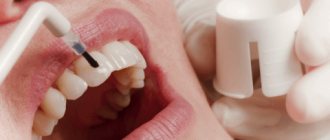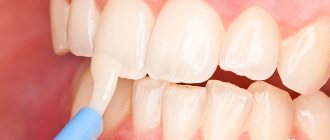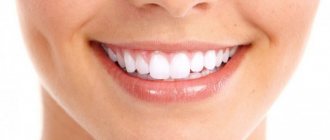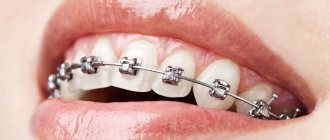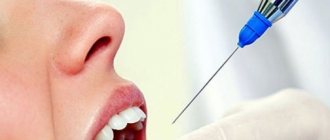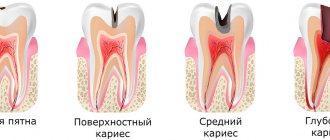Deep fluoridation – a new effective method of fluoridation of teeth used in modern dentistry. This procedure allows you to keep your teeth in a beautiful and healthy condition. The procedure can be performed on both adults and children. In practice, this procedure is used very often and the results obtained clearly demonstrate the reliability and effectiveness of this method.
It is recommended to regularly carry out deep fluoridation of teeth, as this procedure increases the strength and strength of teeth and has not only therapeutic, but also preventive value. A damaged tooth can no longer be restored, it is better to perform prevention!
Deep fluoridation of teeth, unlike the conventional fluoridation procedure, is carried out with a special sealing solution that penetrates deeply into the tooth enamel and remains there in the form of calcium fluoride deposits. This effect of a fluoride-containing substance deep in the tooth enamel is much more effective than simple surface treatment of teeth with conventional fluoridation.
What is deep fluoridation of teeth
Fluoridation is performed to strengthen and protect tooth enamel.
Deep fluoridation of teeth involves applying fluoride and calcium-containing preparations to the enamel. The purpose of the procedure is to strengthen the hard tissues of the tooth and protect them from the effects of food acids and pathogenic microorganisms, the result of which is the development of caries.
The principle of manipulation is as follows:
- a preparation containing fluoride is applied to the cleaned tooth surface;
- as a result of the reaction of element ions with solid tissues, calcium fluorides are formed;
- the interaction of fluorides and hydroxyapatites that make up dental tissue leads to the formation of fluorapatites.
The consequence of this process is an increase in the resistance of the enamel to external influences and a decrease in its permeability. Fluoride compounds prevent the activity of pathogenic microorganisms, accelerate the metabolism of enamel protein and improve the quality of saliva.
Fluoridation methods
There are 4 options for introducing additional fluoride ions into tooth tissue:
1. Fluoridation of drinking water.
2. Taking fluoride in tablets or with fluoridated products (table salt, etc.).
3. Regular brushing of teeth with fluoride toothpastes.
4. Applications of fluoride-containing preparations (fluoride varnishes, gels, etc.).
The most effective of them are the first and third, the least effective is the second. As for the latter method, it brings tangible benefits, but only to those people who ignore more effective fluoride prophylaxis options. Those. drink water with a low concentration of fluoride (less than 1 mg/l) and do not use toothpastes with fluoride (or brush their teeth rarely and not very carefully).
Kinds
In dental practice, three methods of fluoridation of teeth are used:
- Simple fluoridation. Fluoride varnish is applied to the tooth surface or special trays and trays filled with gel with active elements are fixed. The duration of exposure to the composition is 10-20 minutes, and the number of sessions ranges from 10 to 15. The manipulation can be carried out in a dental office or at home. The regularity of its repetition depends on the condition of the tooth surface and predisposition to caries, and is 2-5 sessions per year.
- Deep fluoridation. The enamel is coated with a special solution, from which fluoride ions are released, penetrating deep into the tooth and transforming into strong compounds, which helps strengthen hard tissues. The procedure is carried out exclusively by a specialist and is repeated once a year.
- Electrophoresis. Strengthening of enamel occurs due to the effect of electric current on the tooth surface, which is successively coated with solutions of calcium gluconate and sodium fluoride. The therapeutic course consists of 10 procedures.
Stages
- Cleaning the surface of teeth from soft plaque and tartar;
- Drying – the surface of the teeth must be dried as much as possible for high-quality fluoride varnish coating;
- Applying a composition with fluorides, magnesium and copper salts using a special brush or a sterile cotton ball;
- Repeated drying for 5-7 minutes naturally;
- Treatment with a composition containing calcium hydroxide.
The formed durable film on tooth enamel, consisting of fluoride ions, is resistant to drinks, food, hygiene procedures, does not fade or deteriorate over time.
Indications
Superficial caries is one of the indications for fluoridation of teeth.
Dentists recommend using the deep fluoridation service in the following cases:
- increased sensitivity of enamel;
- superficial carious lesions of the tooth surface;
- the need for non-invasive fissure sealing;
- inflammation of the ligamentous apparatus in the area of the tooth neck;
- accumulation of yellow plaque in the gingival area;
- completion of the orthodontic treatment process and removal of the braces;
- prevention of enamel thinning and caries development in childhood.
When is remineralization indicated?
Proper nutrition and oral hygiene are very important, but not always sufficient conditions for maintaining dental health. In order for prevention to be complete, remotherapy-remineralization should be carried out regularly. This procedure gives good results in restoring enamel after whitening. It is used as a preparatory stage before bleaching, but after hygiene. Remotherapy can be clinical or home (as prescribed by a doctor).
The procedure is also indicated for:
- large-scale anti-caries therapy;
- hypersensitivity;
- after removing braces;
- pregnancy.
How to treat teeth with fluoride step by step
The deep fluoridation procedure consists of the dentist performing the following steps:
- Preparing teeth . The specialist removes mineralized deposits and bacterial plaque from the patient’s enamel.
- Drying the enamel . With the help of warm air, moisture particles are removed from the tooth surface, which can prevent the penetration of active elements.
- Application of the drug . The surface of the teeth is coated with an enamel-sealing compound containing fluoride and magnesium. After 2-3 minutes, the teeth are again exposed to a stream of warm air.
- Copper hydroxide coating. Using a cotton swab dipped in copper hydroxide milk, the dentist scrubs the tooth surface. This promotes the formation of calcium fluoride crystals, which penetrate into the hard tissues of the elements of the jaw row and strengthen them.
- Final rinse of the mouth.
When is fluoridation contraindicated?
If your doctor recommends that you undergo fluoridation of your teeth with fluoride varnish or another preparation applied to the surface of the tooth, this means that you could, if you tried, avoid this. More precisely, this is how it should be, but unfortunately, many dentists themselves do not understand this and recommend fluoridation to everyone indiscriminately. Do not rush to agree if you know for sure that you are using fluoridated water or (adequately) brushing your teeth with fluoridated toothpaste. Another criterion for refusing professional fluoridation (i.e., performed by a doctor) is the absence of new caries over the past year. If more than 12 months have passed since the last cavity discovered, then your dental care can be considered good and additional fluoridation can be ignored.
Features of fluoridation of baby teeth for children
The safety and non-traumatic nature of the fluoridation procedure allows it to be performed on children during primary occlusion without the use of anesthesia. Dentists call the optimal age for manipulation to be 2-4 years.
During primary occlusion, simple, deep fluoridation or electrophoresis is permissible. In mixed dentition, sequential coating of the dental surface with compounds based on magnesium, calcium and copper is more often used.
Reference! Deep fluoridation is a preventive, not a curative procedure. It helps to increase the resistance of enamel to external influences, but cannot eliminate advanced caries, which requires invasive treatment.
Fluoridation during pregnancy
Pregnancy is not a contraindication for fluoridation.
Indications for the procedure during pregnancy are increased sensitivity of the enamel and a tendency to form carious lesions. The manipulation can be carried out in any trimester , since it is performed locally and does not require the use of an anesthetic. The only contraindication is toxicosis.
The method of fluoridation is selected by the dentist based on an examination of the patient’s oral cavity. The application of fluoride varnish is often used to prevent damage to the enamel; deep fluoridation is used in cases of increased sensitivity of teeth.
During breastfeeding, fluoridation is also permitted.
Expert opinion of RAIDEN specialists
The fluoridation procedure is useful for the teeth of young patients, subject to indications for its implementation and taking into account contraindications. Fluoride is certainly useful for the formation of a growing organism. Its deficiency during the formation of the dental system can affect not only the health of the teeth, but also the entire body as a whole. Excess is also harmful. Therefore, the correct dosage of fluoride varnish during the procedure is an important point. Fluoridation “within reasonable limits” is a means of avoiding more complex, expensive and painful treatment. It is better to prevent any disease than to treat it. Prices for dental fluoridation depend on the amount of work.
Advantages and disadvantages
Dentists who carry out the deep fluoridation procedure note that the technique has both advantages and disadvantages.
| Advantages | Flaws |
| High effectiveness , which consists in strengthening the enamel, reducing tooth sensitivity, preventing the risk of developing caries, and increasing the service life of installed fillings. | The development of fluorosis as a result of oversaturation of teeth with fluoride. |
| Duration of effect – fluoridation provides protection of the tooth surface for a period of six months to a year. | Fluoride intoxication if the technology for performing the procedure is not followed, which threatens the destruction of bone tissue, joint deformation and pathologies of the endocrine system. |
| Availability – the procedure is available at most dental clinics. | High cost of the procedure. |
| Painless, so no anesthetic is required. | |
| Versatility and a minimum number of contraindications, allowing manipulation for children and pregnant women. |
Contraindications
Fluorosis is an excess of fluoride.
Restrictions to the procedure are the following health characteristics of the patient:
- Diabetes. Increased fluoride levels interfere with the proper absorption of sugar, leading to disturbances in the functioning of the pancreas.
- Excess of the element in the body. A high content of non-metal in food and water consumed by humans, combined with local administration, can lead to the destruction of enamel.
- Allergy to the components of the drugs used.
- Fluorosis is damage to the enamel as a result of the presence of excess fluoride in it.
Fluoridation at home
There are several options for performing fluoridation at home: the use of drugs containing a chemical element and the use of medicinal pastes and rinses.
Special gels, preparations, fluoride varnish
Fluoride varnish is one of the preparations for home use.
Gels and varnishes for home use contain sodium fluoride, which forms a thin film on the enamel that protects teeth from damage and exposure to pathogenic microflora.
The drugs that can be used independently include: “Sensigel”, “Dental Resources Revive”, “Ftorlak”, “Topex 60 second fluoride Gel”.
These products can only be used after consultation with your doctor and in accordance with the manufacturer's instructions.
Be careful! Careless handling of fluoride-containing gels can lead to their contact with mucous membranes, which can lead to poisoning.
Pastes and rinses
One of the most popular means of prevention is the use of fluoride-containing pastes.
The fluorine content in therapeutic and prophylactic pastes of well-known brands reaches 0.14-0.15%. The dosage of the active element can range from 600-800 ppm in children's products to 1500 ppm in products for adults.
Popular pastes containing fluoride are: President Classic, Blend-a-med Complete, Colgate Elmex, El-ce med Total Care, Silca Herbal Complete.
The use of fluoride-containing rinses and elixirs, in addition to freshening breath, helps wash out the smallest particles of food from the interdental spaces and enrich the enamel with useful substances. Therapeutic and prophylactic rinses are present in the assortment of the brands “Lesnoy Balsam”, “Splat”, “Colgate”.
Popular questions
When preparing for a deep fluoridation procedure, patients have many questions, the answers to which are provided by dentists:
- Do you need to brush your teeth before fluoridation? Removing bacterial plaque and mineralized deposits is a mandatory stage of the procedure, allowing the active components to penetrate hard tissues and strengthen them.
- Why are mouthguards needed for fluoridation? Dental mouthguards are used during superficial procedures. Fluorine-containing paste is placed in them, after which the products are fixed on the jaw rows for 15-20 minutes. This ensures long-term and close contact of the active components of the gel with the teeth to saturate them with mineral elements, and also prevents leakage of the composition into the oral cavity.
- When can you eat after fluoridation? When the drug is applied superficially, the consumption of food and drinks is allowed 3-4 hours after the manipulation; after deep fluoridation, such breaks are not required. The only limitation is the intake of very hard foods and hot dishes and liquids during the first 24 hours, as they can damage the protective film formed on the tooth surface.
- Is fluoridation harmful? Carrying out the procedure in compliance with the acceptable frequency and safety precautions when working with fluoride-containing paste and gel does not cause harm to the human body and its oral cavity.
Before and after the procedure.

